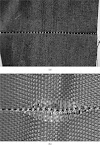Different Knitted Fabric And Their Properties
1. Single Jersey
1) Structure – Single jersey has either face loop or back loop in their structure.
2) Irreversible – Single jersey is irreversible fabric as the appearance of fabric on both sides are different.
3) Curling Pattern – It has high curling tendency with sides of fabric curling towards back side and top and bottom of fabric curling front side of the fabric.
4) Extensibility – Single jersey has extensibility greater width wise (Approximate double) as that of length wise.
5) Thickness – Single jersey has less thickness than the double jersey due to less number of loops per unit area.
6) It requires only one set of needle to produce.
7) Production – Thus production is more than double jersey.
8) Cost – Cost of the fabric is less than the double jersey.
9) Unravelling – Unravelling of the yarns can be possible from both top and bottom side of the fabric. But the top side can be easily unravelled.
10) Applications – Leggings, sports t-shirt, regular t-shirt, etc.
2. Rib
1) Reversible – Rib fabric is reversible i.e. appearance of the fabric on front side and back side are same.
2) Vertical cord like effect is observed in between ridges.
3) Thickness – Thickness of rib fabric is almost double than the single jersey fabric.
4) Unravelling – Unravelling is possible only from top side.
5) Extensibility – Rib fabric has most extensibility than other any other fabric.
6) Curling Tendency – It has no curling tendency i.e. it is stable fabric. Thus garmenting operations can be performed easily.
7) Their are two types –
1) Balanced rib (1*1, 2*2)
2) Unbalanced rib (2*1, 3*2)
8) Applications – Collar, cuff, band, sleeve, etc.
9) Opaque structured rib – It is non transparent structure which mainly used for swimsuit, sweaters, also used in western countries for outerwear for warmness.
3. Interlock
1) Structure – It is basically interlocking of two 1*1 rib structure.
2) It is complex to show intermeshing on paper.
3) Reversibility – Simple interlock structure is reversible.
4) Extensibility – It has very less extensibility i.e. it is a firm fabric. Thus easy for garmenting operations.
5) Thickness – Thickness of the interlock structure can be compared to the double cloth woven fabric.
6) Curling Tendency – As this structure is firm, it has no curling tendency.
7) Unravelling – Unravelling can be possible from the coarse knitted at last.
8) Production – Two coarses make one effective coarse, thus production rate reduced to half for the same speed on that of single jersey.
9) Cost – Interlock fabric cost is more than other knitted fabric due to more thickness and less production.
10) Applications – Garments, collar, polo shirts, sleeve, trousers, etc.
4. Purl Fabric
1) Structure – Here in this structure face loop coarse and back loop coarse are knit alternatively.
2) Reversible – Purl fabric is reversible. Semicircles of needle and sinker loops are seen on both face and back side of the fabric.
3) Extensibility – Purl fabric creates extensibility in length way
4) Thickness – Thickness of the purl fabric is theoretically double than plain knitted fabric.
5) Curling Tendency – This fabric has no curling tendency as the structure includes alternate face loop and back loop coarse, thus it balances the fabric.
6) Unravelling – Purl fabric can be unrove from either side.
7) Production – Production is less as compared to other weft knitted fabric.
8) Thus structure requires double hook needle.
9) Applications – Infants wear, sports wear, sweaters, etc.
Picture Source - Thread Magazine















0 Comments
If you have any doubts, please don't hesitate to ask